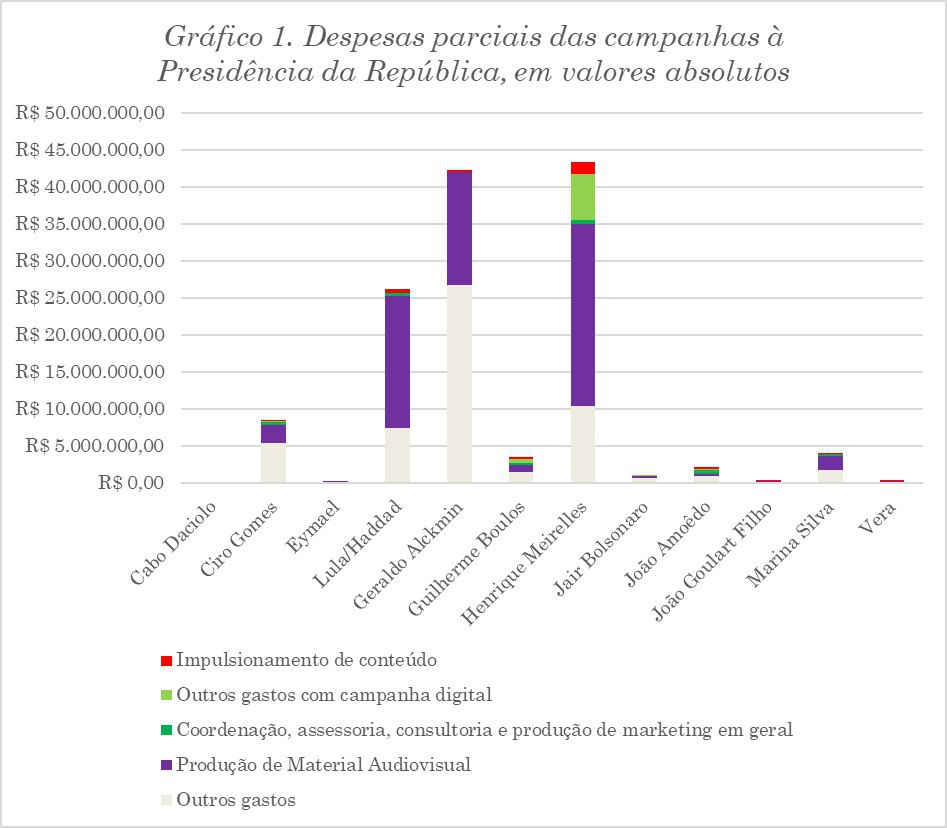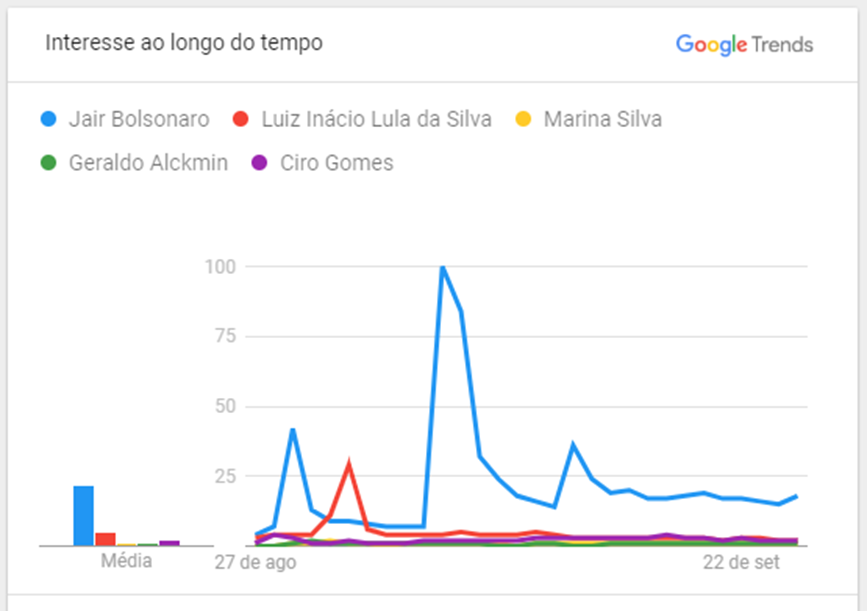
An X-ray of the presidential candidates marketing campaigns
Você na Mira’s second report analyzes data on the campaign spendings and the use of content boosting.
As we have mentioned here, the 2018 Brazilian election will be one of the first ones in which the “boosting of content” will be allowed as the only legal form of paid electoral propaganda on the internet. With the goal of bringing more transparency to the online campaigns, InternetLab released, in partnership with WhoTargets.Me, the project Você na Mira which allows the monitoring of microdirected political propaganda on Facebook. Based on the data collected during the electoral period, we are publishing a series of reports about digital marketing actions of the campaigns. The first report [in Portuguese] covered the whole pre-campaign period and looked to some of the boosting strategies of the pre-candidates to the presidency and the government of 12 states.
On this second report [in Portuguese], our goal was to make a preliminary X-ray of the candidacies’ digital marketing practices. Our analysis encompassed other data sources other than Você na Mira and was built from three layers of information: (i) the campaign spendings declared on the partial reports to the Electoral Justice; (ii) the information about advertising which is publically shared by the internet companies; (iii) ads and information about the directing of content on Facebook collected by Você na Mira‘s plugin.
Read the full report here [in Portuguese].

The expenses of the presidential candidates on the first month of the campaign
On the first month of the campaign, from the candidates’ partial expense reports, we identified a scenario in which the expenses with the boosting of content were centered on Facebook and Google, and represented a small fraction of the values declared so far to the Electoral Justice. Even if there is still a significative budget difference between the campaigns, none of them massively invested in the boosting of content if we consider the total spendings of each of them. In a comparative analysis with the values that went to audiovisual productions, the expenses with the boosting get even smaller, representing a tiny fraction.
Among the top candidates on the surveys — with over 5% of intentions — an interesting topic to be observed is the lack of expenses by Jair Bolsonaro with the boosting of content during this period. According to his partial report and the Facebook Ad Archive, the top candidate on the polls for the voting intentions did not boost any ad on Facebook on the first month of the campaign. Still, despite his lack of paid advertisement on the internet, the candidate kept the most significant level of engagement on the social networks and had the most substantial amount of interest on Google Brasil platforms over the last 30 days, according to Google Trends.

In the face of this disproportion between the investment of Bolsonaro’s campaign on social media and the relevance of the candidate on these spaces, two topics have to be taken into account when analyzing this phenomenon: (i) the capillary network of candidacies for governor, senator, and federal and state deputies which supported the PLS candidate in their respective boostings — in a kind of “crossed boosting”, not controlled directly by the presidential candidacies registry; and (ii) the candidate’s capacities of gathering volunteers and generate spontaneous engagement on the social networks. The hypothesis that the political forces of Bolsonaro’s candidacy on the social networks is a phenomenon which resulted from a distributed effort, capillary and voluntary, was corroborated, as it is visibly more prominent than the ones of his opponents.
The use of the Facebook boosting tool by the presidential candidates
Even as the campaigns invested relatively little on the boosting of content, it is interesting to look at the quality of these expenses, that is, how the money is spent. The campaigns of candidates Henrique Meirelles, Guilherme Boulos, and João Amoedo stand out in this sense, as they tried to aggregate elements of microdirecting and communication strategies to their campaigns.
Among the ads identified by Você na Mira during the first month of the campaign, some of the diagnoses regarding the boosting of content by the presidential campaigns from the last report were confirmed. For example, the microdirecting of posts to a younger audience, in the case of Guilherme Boulos. Nonetheless, some other practices deserve to be highlighted.
One directing strategy that deserves to mentioning was João Amoedo’s use of Facebook boosting to reach people who are similar to his “clients.” This functionality allows the advertiser to create a personalized audience from determined characteristics and direct ads to people alike. The use of this tool is an indication of the use of more sophisticated tools of microdirecting by the candidate that, due to a smaller time on television and not being among the candidates invited for the debates, relies more on the social networks to publicize his candidacy.

The ads created by Henrique Meirelles and Guilherme Boulos directed to women are also worth noticing. In an election in which the first candidate on the polls broadcasts sexist speeches and has a high rate of rejection by women, it is interesting to look at the communication strategies of other candidates with this section of voters.
Meirelles boosted a video in which he criticized the lack of propositions for women on Bolsonaro’s government plan and directed it towards an audience with interest on the subject woman and to an audience made by women over 18-years-old or more. As for Guilherme Boulos, the candidate boosted a video of his participation on the Band debate in which he presents his propositions for women. This ad was directed to an audience interested in feminism and to an audience made by women from 16 to 40-years-old.

The full report with all data collected by the team during this first month can be accessed here. [in Portuguese]
________________________
Team resposible for the content: Heloisa Massaro and Francisco Brito Cruz . With the collaboration of Beatriz Kira.
Project team: Francisco Brito Cruz, Lucas Lago, Heloisa Massaro, Sam Jeffers, and Louis Knight-Webb.
Institutional team: Mariana Valente and Dennys Antonialli.